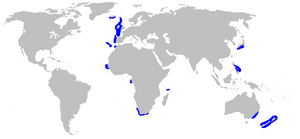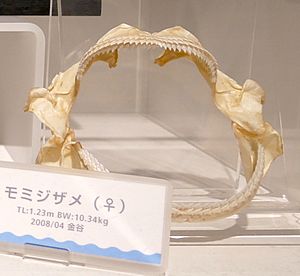Leafscale gulper shark facts for kids
Quick facts for kids Leafscale gulper shark |
|
|---|---|
 |
|
| Drawing by R. Mintern | |
| Conservation status | |
| Scientific classification | |
| Genus: |
Centrophorus
|
| Species: |
squamosus
|
 |
|
| Range of leafscale gulper shark (in blue) | |
| Synonyms | |
|
|
The leafscale gulper shark (Centrophorus squamosus) is a type of dogfish shark. It belongs to the Centrophoridae family. This shark can live for about 70 years. It was the first shark described in its group, called Centrophorus, which now has 13 different species.
Contents
What It Looks Like
The leafscale gulper shark has no anal fin (a fin on its belly). It has two dorsal fins (fins on its back) with spines. The first dorsal fin is quite low and long. This shark also has large eyes. Its skin is covered in rough, leaf-like denticles. These are like tiny scales. The shark can grow up to about 158 centimeters (5 feet 2 inches) long.
Where It Lives
This shark lives in many parts of the world's oceans. You can find it in the eastern Atlantic Ocean. This includes areas from Iceland down to the Cape of Good Hope in Africa. It also lives in the western Indian Ocean near the Aldabra Islands. In the western Pacific Ocean, it is found around Honshū, Japan, the Philippines, southeast Australia, and New Zealand. It usually lives near the continental slope, which is the edge of the continent underwater.
Life in the Deep Sea
The leafscale gulper shark usually lives near the ocean bottom. It can be found between 230 and 2,360 meters (750 to 7,740 feet) deep. Most often, it lives below 1,000 meters (3,280 feet). Sometimes, it swims in the open ocean, far from the bottom, in very deep water. This shark likely eats fish and cephalopods, like squid and octopuses.
Reproduction
This shark is ovoviviparous. This means the eggs hatch inside the mother's body. The young then develop inside her. The mother shark can have up to five young sharks at a time. People use the meat of this shark. It is dried and salted for food. It is also used to make fishmeal, which is food for other animals.
Protecting the Shark
The New Zealand Department of Conservation checks on this shark. They have said the leafscale gulper shark is "Not Threatened." This means it is not in danger of disappearing. They also added "Secure Overseas," which means it is safe in other parts of the world too.
See also
 In Spanish: Quelvacho negro para niños
In Spanish: Quelvacho negro para niños



